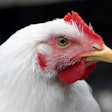
Keeping early chick mortality low is essential for profitable broiler production and there are numerous checks and measure that producers can take to ensure chick survival.
Excessive broiler mortality can have a significant impact on profit margins for both growers and integrators. Producers should take precautions early in order to stay within the expected death rate of 1-5% through a 45-day production cycle.
Consider the following steps to reduce early chick mortality.
Evaluate chicks coming into your facility
Good quality chicks should be active, have a body weigh between 40–44 g, have dry down and a healed navel upon removal from the hatcher.
To control the quality of chicks entering the brooding house, work with the integrator to obtain chicks from healthy parent stocks and inspect chicks’ health status prior to transport, or upon arrival, at the brooder house.
Ensure good management
Sound management is indispensable for keeping flocks healthy, alive, and obtaining their full potential. Integrators should:
- Implement strict hygiene practices and biosecurity rules to avoid disease occurrence and spread;
- Closely follow integrator approved vaccinations, preventive treatments and bird density guidelines;
- Minimize handling of birds to avoid injuries;
- Control sudden loud noises since panicked birds will pack together and may suffer injuries or suffocate. Consider providing background noise (e.g.,a radio); and
- Keep accurate, complete records throughout brooding to allow for tracing of issues.
Cull poor performing chicks
After 3-4 days, the yolk sac is depleted and poor performing birds are easy to identify by their abnormal behavior. Train personnel to recognize these birds and cull them immediately. Culling poor performing chicks provides better conditions for the healthier birds, minimizes impact on feed conversion ratio and improves flock uniformity.
Maintain appropriate brooding temperature
When temperatures are too high, birds will dehydrate, drink more and eat less, potentially resulting in bird death from lack of feed or pasted vent. When temperatures are too low, chicks will huddle together, which can result in suffocation or injury. Monitor temperatures closely, centralize heating sources, and design pens so that bird are comfortable throughout the house.
Maintain appropriate humidity
High relative humidity results in wet litter, which increases the potential of a disease outbreak. In addition, ammonia levels can increase to above 25 ppm, which can lead to stress, mucosal membrane irritation, and respiratory diseases. Ensure brooding houses have proper ventilation and remove wet or caked litter from pens.
Monitor for poisoning/contamination
Chicks have limited ability to survive toxic conditions, and it is important to:
- Minimize contact with disinfectants and residue insecticides;
- Check litter for contamination as well as compatibility with chicks. For example, eating too much sawdust can cause gastrointestinal impaction and ultimately death; and
- Inspect for, and destroy, moldy feed. Protect feed from mold by keeping it away from water, storing in sealed containers with low humidity and checking expiration dates.
Supply chicks with sufficient feed, water
Sufficient high-quality water and feed is essential for chick growth and survival. In addition to ensuring water and feed is available:
- Provide chicks with water before feed to divert some chicks’ attention to water and reduce the initial rush and struggle for feed;
- Distribute feeders and waterers throughout the house to avoid crowding;
- When using nipple drinkers, supplement with bell drinkers during initial brooding - chicks need time to learn how to use nipple drinkers;
- Provide extra feed on paper or trays during initial brooding to ensure all chicks can find feed;
- Clean drinkers and feeders daily, and discard any leftover water and feed; and
- Test water and feed quality.
Control predators
Chicks are attractive targets for predators such as cats, rats and hawks. In addition to eating chicks, predators can scare and stress the birds.
- Monitor for signs of predators;
- Routinely inspect and repair holes, gaps and other possible predator entryways;
- Install an electric fence to surround the broiler house area. For flying predators, crisscross a thin cord over the area or, alternatively, install strong iron mesh nets;
- Apply predator repellents regularly; and
- Discard leftover water and feed far away from the houses.
Control diseases
Even when diseases are not fatal, they still impact a bird’s ability to grow. It is important to:
- Check the flock at least daily for disease symptoms;
- Remove birds with disease symptoms and contact a veterinarian;
- Follow the integrator’s medication and vaccination schedule; and
- Even if a bird recovers from infection, do not return it to the flock. Recovered birds may still be able to spread an infection.

















